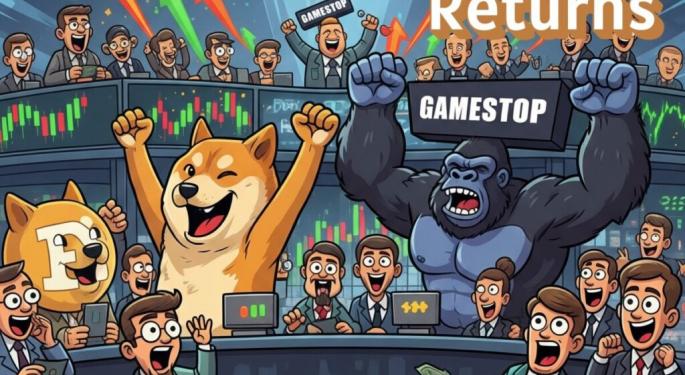Meme Stocks Return: What's Powering The Revival
Retail investors appear to be using the momentum of the S&P 500 to target meme stocks in a bid to create a similar short squeeze to that of GameStop during 2021's meme frenzy.
Recent days have seen a number of Wall Street stocks experience price surges spanning a range of sectors. Among the biggest movers of late have been GoPro (GPRO) and Krispy Kreme (DNUT), with the stocks rallying 56% and 18%, respectively, in morning trading on Wednesday, July 23.
The market movements have caused camera firm GoPro to double in value in July alone, while investor attention has helped rescue doughnut maker Krispy Kreme after the stock shed more than 70% of its value in the first half of 2025.
Shortly before GoPro and Krispy Kreme's rally came sharp price rallies for apparel retailer Kohl's (KSS), which opened 90% higher on Tuesday, July 22, and buying website Opendoor (OPEN), which climbed 20% at the beginning of trading.
Crucially, none of these stocks had popped because of any tangible business updates, but they had all featured frequently on the forums of r/WallStreetBets, a Reddit page that's heavily used by retail investors hoping to make quick profits through peer-driven trading strategies.
Recent days have also brought significant investor interest in stocks like 1-800-Flowers.Com (FLWS) and Beyond Meat (BYND) as almost one quarter of US stock orders came from retail traders.
The Return of the Memes
What's powering the meme stock revival? One of the key factors that has made the return of meme investing seem like an inevitability is the sheer rise in retail investor interest in Wall Street.
According to the Financial Times, individual investors have poured a record $155 billion into US stocks and exchange-traded funds in the first half of 2025, representing a higher total value than the meme stock frenzy that sparked rallies for GameStop (GME) and AMC Entertainment (AMC) in 2021.
Optimism has also been flowing into the S&P 500, which has reached 11 record highs this year with semiconductor giant Nvidia (NVDA) becoming the world's first stock to surpass a market capitalization of $4 trillion.
Growing retail investor sentiment was underlined in a Goldman Sachs index tracking retail investor favorites based on popular equities among individual traders. The index reached an all-time high in mid-July, surpassing its peak set in early 2021.
Learning Lessons from GameStop
Retail investors inspired by the ongoing meme stock revival can look to the performance of GameStop as a lesson in the opportunities and dangers that speculative stocks present.
GameStop rallied 1,738% in the span of three weeks in January 2021 after institutional short interest prompted a short squeeze as masses of retail investors bought into the under-loved stock.
However, the rally was so brief that many individuals who bought in closer to GameStop's peak faced heavy losses. GME ended the first half of 2025 still more than 70% below its all-time high value, and it's clear that sentiment has shifted to a fresh range of stocks that institutional investors have undervalued.
There are clear lessons to be learned from the past that can help more retail investors navigate the ongoing meme resurgence in a more sustainable way.
While the case of GameStop shows that institutional short interest is an excellent platform for meme investing, it shouldn't be considered the sole reason to buy. The GameStop trend also illustrated how retail investors need to maintain a level-headed approach and a critical outlook even as a stock gains a passionate community of investors.
Successful Meme Investing
Speaking on Yahoo Finance, Ritholtz Wealth Management chief market strategist Callie Cox has recommended that investors wanting to embrace the meme stock rally remember to set targets and understand their exit strategy better.
Meme stock frenzies are characterized by extreme volatility, and without fundamentals to support a stock experiencing high levels of sentiment, the value of companies can fall extremely sharply.
One of the most effective ways to embrace meme investing is to build a diversified portfolio to help support sustainable growth alongside your more speculative investment strategies. As a whole, your meme stock investing should represent a marginal portion of your portfolio that you can afford to lose.
What's Next?
Highly speculative investment patterns like meme investing have been associated with a frothy market, with some investors believing it could be a sign of an impending pullback.
However, there's no strong correlation between meme investing and market frothiness, and recent trends appear to be retail investors channeling their optimism in Wall Street into more speculative equities.
With history serving as a recent lesson for meme investors, there's potential for more individuals to take a measured approach to meme stocks. However, the same old dangers remain for those who are slower to join the frenzy.
Disclosure: On the date of publication, Dmytro Spilka did not hold (either directly or indirectly) any positions in the securities mentioned in this article. The opinions expressed in this article are those of the writer. Dmytro Spilka does not intend to make a trade in any of the securities mentioned above in the next 72 hours.
Benzinga Disclaimer: This article is from an unpaid external contributor. It does not represent Benzinga’s reporting and has not been edited for content or accuracy.
Posted-In: contributors Expert IdeasEquities Opinion Markets Trading Ideas General



